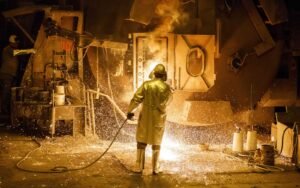Steel, one of the most essential materials in modern construction, manufacturing, and infrastructure, has a history that spans thousands of years. Its origins date back to ancient civilizations, and the process of making steel has evolved significantly over time, becoming an integral part of industrial progress.

Early Discoveries and the Birth of Steel
The discovery of steel is believed to have occurred around 4,000 years ago, although it wasn’t until much later that the modern steelmaking process was developed. Early civilizations discovered that when iron was heated and combined with carbon, it became stronger and more durable than pure iron. This led to the early forms of steel being created, although these methods were primitive by today’s standards.
- The Iron Age:
The history of steel began during the Iron Age (around 1200 BCE to 500 BCE), when iron began to be used widely for tools and weapons. During this period, civilizations such as the Hittites in ancient Anatolia (modern-day Turkey) are believed to have discovered how to make steel by heating iron in a furnace and adding carbon from charcoal. This process improved the material’s strength, making it ideal for weaponry and tools.
The Development of Steelmaking Processes
While ancient civilizations were able to produce rudimentary forms of steel, it wasn’t until much later that a consistent and reliable method for steel production was developed.
-
The Wootz Steel (around 300 BCE):
One of the earliest known forms of high-quality steel was Wootz steel, which was produced in India around 300 BCE. This form of steel was renowned for its durability and ability to hold a sharp edge, and it was used to create high-quality weapons and tools. The Wootz steel-making process involved melting iron with a combination of carbon-rich materials, such as plant matter or charcoal, to create a unique crystalline structure in the steel. -
The Bessemer Process (1856):
Steel remained a relatively rare and expensive material until the Bessemer process was invented in 1856 by British engineer Henry Bessemer. The Bessemer process involved blowing air through molten iron to remove impurities and control the amount of carbon in the steel, which made it possible to produce large quantities of high-quality steel at a much lower cost. This revolutionary method helped fuel the industrial revolution and made steel more accessible for use in infrastructure, machinery, and construction. -
The Open-Hearth Process (1860s-1960s):
In the 1860s, the open-hearth process was developed, which allowed for larger batches of steel to be produced in furnaces with controlled temperatures and material additions. This method, which became widespread in the late 19th and early 20th centuries, was instrumental in increasing steel production for large-scale industrial needs, including the creation of railways, ships, and buildings.
The Modern Era of Steelmaking
Today, steel production continues to evolve with even more advanced processes, including the Electric Arc Furnace (EAF) method, which allows for the recycling of scrap steel and offers a more environmentally friendly approach to steelmaking.
- Electric Arc Furnace (EAF):
The EAF process involves melting recycled scrap steel using electrical arcs and then refining it to produce new steel. This method has gained popularity in recent decades due to its efficiency and the ability to reduce the carbon footprint of steel production.
Conclusion: Steel’s Legacy and Impact
Steel’s journey from ancient discoveries to modern industrial processes demonstrates its importance in the development of human civilization. From the early ironworkers of the Iron Age to the industrial revolution’s transformation of manufacturing, steel has been a key driver of progress.
Today, steel is the backbone of many industries, including construction, automotive manufacturing, energy production, and even aerospace. The discovery and advancement of steelmaking techniques have allowed for the creation of skyscrapers, bridges, railways, and a host of other infrastructure that shape the world we live in. Its durability, versatility, and strength ensure that steel will continue to be an essential material for future generations.





No Comment